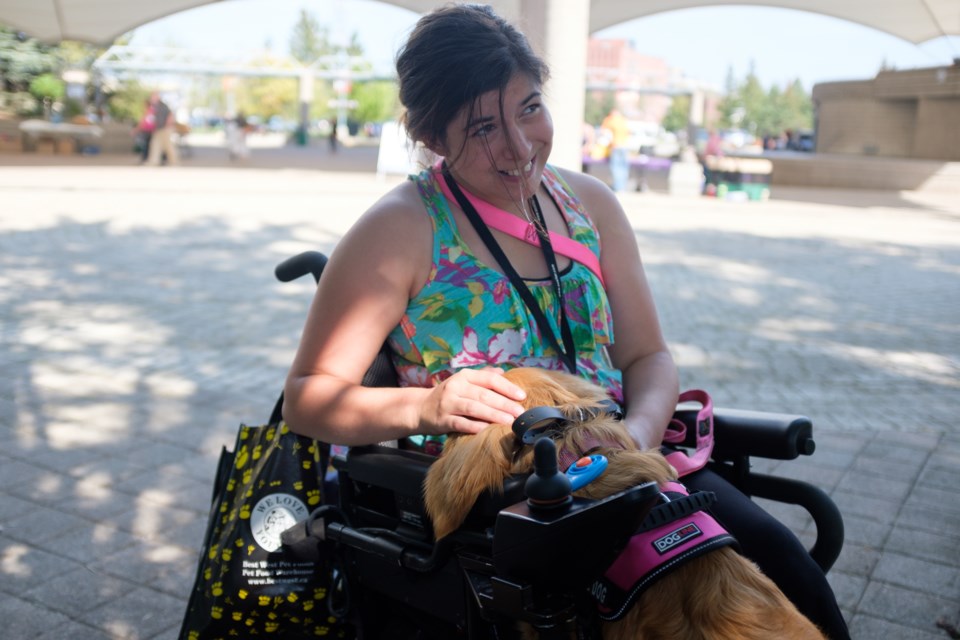Jurnee Stadnisky isn’t a professional dog trainer, but when she decided she wanted a service dog, she thought she’d train one herself.
It’s perhaps a little known fact that she is completely entitled to do so.
Stadnisky was born with spastic cerebral palsy, a birth condition that affects her lower limbs and causes muscle tightness and spasms throughout her body.
Because she can’t walk, except to transfer from places like her chair to her bed, she uses a wheelchair. And because her facial muscles can’t form the proper shapes for speech, she uses sign language and mobile phone apps to communicate.
With translation help from a friend, Stadnisky told her story to SooToday.
Stadnisky, now 22 years old, first wanted to get a service dog two years ago.
Sitting in a wheelchair all day is hard on her back and as she is getting older, it's becoming difficult to bend over.
She was looking for a dog to help pick things off the floor but to also open doors, retrieve things, and provide anxiety support.
She originally approached the Lions Foundation about getting a dog through them, but she would have been put on a year-long waiting list, at least. And most of their dogs are Labrador retrievers which she felt were too hyper for her.
Stadinsky discovered through online research that it was possible to train one's own service dog. Although it seemed like a challenge, she felt she was up to it.
“(Among those) training their own service dogs, there is a 70 to 80 per cent wash-out rate based on research,” said Stadnisky. “Especially if you don’t build a support system.”
With the help of her friends, family, and community, Stadnisky set up a GoFundMe, collected nearly $3,000 in donations, and in the spring this year she went to Golden Pride Kennels in Echo Bay to meet with puppies for temperament testing.
Temperament testing determines if a dog has the right kind of personality for service dog training.
It involves five tests: A drop test to see how the animal reacts being dropped a few inches, a light paw pinch test to see if they flinch in pain or pull away, a loud sound test, a dominance test where they hold the puppy like a human baby to see if she squirms, and a play test where they just play with the dog and see how it reacts.
In May 2017, Stadnisky received her adorable golden retriever puppy, Beka.
The first thing she did was train her to do regular dog stuff like to go to the bathroom outside and crate training.
This was followed by typical professional dog trainer-assisted obedience training like getting her to sit, come, leave, etc.
Now two months into training, and building on foundational skills she learned from her professional trainer, Stadnisky is teaching Beka how to walk beside a wheelchair safely and pick stuff off the ground for her.
Stadnisky took Beka to the Humane Society’s annual Cause for Paws dog walk fundraiser on Saturday so the dog could get accustomed to being in a ‘high distraction environment’ with lots of pets and people.
Usually Stadnisky just uses love and attention as a reward for her dogs, but in busy environments she will use treats.
She’s hoping to get Beka up to the level where she will be able to retrieve large objects, turn lights on and off, help her balance while transferring from her chair to her bed, and to bark on command as an emergency signal to others.
Beka will also be able to open doors by pressing the power assist buttons or by pulling a door open using a hook, then holding it open as Stadnisky passes through.
Beka will also act as an anxiety aid for Standinsky.
When she’s feeling down — and somehow Beka can just sense it — she will lay her head on Stadnisky’s lap and maybe lick her hands.
The pressure and heat helps to ground Standnisky in the moment.
Besides the practical reasons for having a service animal, Stadnisky said having a dog around is just a good way to get her out of bed every day even if she’s in pain from her condition.
Former accessibility trainer for Ontario Disability and owner of Accessibility North, Dawna Kinnunen, said that the public is often unaware that a person can train their own service dog.
"Training doesn’t have to be formal training by an organization, you can train the dog yourself,” she said. “The law is that you can train your own service dog because the legislation says they are allowed to have an animal with them because of their disability, not because of the dog's training.”
Kinnunen said if someone goes into a business with their service animal, the only proof they need to show is a doctor’s note or prescription acknowledging the need for an animal — no training certification is required for the animal.
Kinnunen championed Stadinsky’s efforts.
“She spends time every day doing training… I think it’s amazing,” she said. “It’s very courageous, very brave, she’s super committed. I think very highly of her.”
